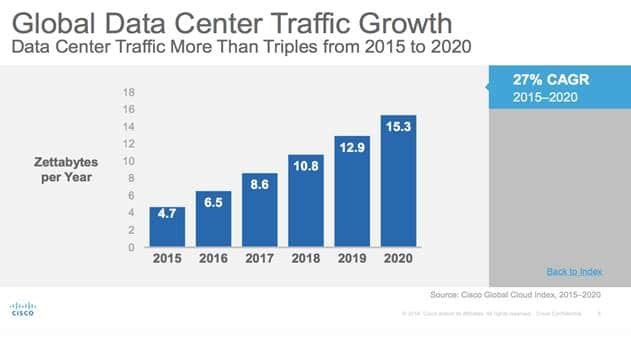Cloud traffic is expected to rise 3.7-fold, up from 3.9 zettabytes (ZB) per year in 2015 to 14.1 ZB per year by 2020, according to the sixth annual Cisco Global Cloud Index (2015-2020).
This rapid growth of cloud traffic is attributed to increased migration to cloud architectures due to their ability to scale quickly and efficiently support more workloads than traditional data centers. With greater data center virtualization, cloud operators are also able to achieve greater operational efficiencies while flexibly delivering a growing variety of services to businesses and consumers with optimal performance.
To better understand data center growth, new analysis on application workloads was developed for this year’s report. The following business and consumer projections were revealed:
i. Business workloads dominate data center applications and are growing. Business workloads will grow by 2.4 fold from 2015 to 2020 but their overall share of data center workloads will decrease from 79 to 72 percent.
ii. Consumer workloads, while smaller in number, are growing faster. During the same time, consumer workloads will grow faster by 3.5 fold. By 2020, consumer workloads will account for 28 percent (134.3 million) of total data center workloads, compared to 21 percent (38.6 million) in 2015.
iii. IoT/analytics/database workloads are growing the most in terms of share of business workloads with collaboration and compute workloads largely maintaining their share. By 2020, database/analytics/Internet of Things (IoT) workloads will account for 22 percent of total business workloads, compared to 20 percent in 2015.
iv. Video and social networking will lead the increase in consumer workloads, each respectively grows their percentage significantly. By 2020: video streaming workloads will account for 34 percent of total consumer workloads, compared to 29 percent in 2015; social networking workloads will account for 24 percent of total consumer workloads, compared to 20 percent in 2015; search workloads will account for 15 percent of total consumer workloads, compared to 17 percent in 2015.
Doug Webster, Vice President of Service Provider Marketing, Cisco
Powered by video, IoT, SDN/NFV and more, we forecast this significant cloud migration and the increased amount of network traffic generated as a result to continue at a rapid rate as operators streamline infrastructures to help them more profitably deliver IP-based services businesses and consumers alike.




















